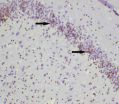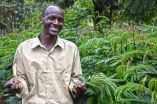(Press-News.org) As towns across Cape Cod struggle with problems stemming from septic systems, a recent study by a Woods Hole Oceanographic Institution (WHOI) scientist focuses on one specific toxic by-product: mercury. In a study of local groundwater, biogeochemist Carl Lamborg found microbial action on wastewater transforms it into more mobile, more toxic forms of the element.
His findings were published in Environmental Science and Technology in November 2013.
Mercury (Hg) is a toxic trace metal. Wastewater contains small amounts of it, but Lamborg found the chemical processes that break down waste increase mercury levels in the ground and water.
Between 2010 and 2012 Lamborg measured the concentrations and various forms of mercury at sampling wells installed by U.S. Geological Survey surrounding a wastewater treatment site operated by the Massachusetts Military Reservation in western Cape Cod. Wastewater was disposed into the ground at this site from 1936 to 1995, creating a 3-kilometer-long plume of contaminants spreading downstream from this site. The plume travels about 200 meters per year through the aquifer and ends in a coastal saltwater pond.
"The amount of mercury flowing out of the watershed and into the ocean and these ponds is something like twice as much as it would be if wastewater was not being put into the ground," said Lamborg, who analyzed the chemistry of the samples in his lab at WHOI.
To better understand why, he looked at two sites along the plume where microbes have broken down the carbon and nitrogen from the waste and have consumed all of the oxygen in the sediment and groundwater, making the sites anoxic.
Near the upstream point of entry, he found the microbes were using iron to break down the waste, a process called iron reduction. In this process, he observed the most common form of mercury, (Hg2+), which, he said, normally sticks to the sediment, was reduced into "less sticky" elemental mercury (Hg0) that more easily seeps into the groundwater and is transported downstream.
At a second sample site further downstream, he found a high concentration of another type of mercury, monomethylmercury (MMHg), which accumulates in fish at toxic levels and can be detrimental to human health.
"In some cases, 100 percent of the mercury present at that location was MMHg," he said. This form of mercury also easily moves through the water and can accumulate in ponds and the ocean, where fish and other animals absorb it.
He quickly adds that the level of MMHg is not high enough to make the water dangerous to drink. However, the concentration would be even lower if wastewater had not been disposed into the ground in the first place.
"This should make us all think twice about what we dump into the ground. Adding more nitrogen into the ground through wastewater, and even fertilizers for our agricultural fields and golf courses, offers a potential for mercury to accumulate and move through the aquifer to our ponds, lakes, and the ocean. That's something I don't think people are really thinking about," he said.
Lamborg looked further into the chemical process occurring at the second site and found something even more surprising. He observed a chemical process where microbes use organic carbon with nitrate to break down organic matter, a process called denitrification. While previous studies have shown low levels of MMHg where denitrification occurs, this site exhibits high levels of MMHg occurring from denitrification.
"This kind of thing where you see denitrification resulting in the methylation of mercury has never been observed before," he said.
Lamborg is pursuing funding to support the next steps in this research to illuminate what is triggering these chemical changes in the mercury.
Accumulating out of sight
Curiously, there is even more mercury in the plume than was originally deposited from the wastewater and produced by the waste-eating microbes. So where is it coming from?
"What it looks like is, the mercury that was already there in the aquifer or sand is being mined out when the groundwater goes anoxic," said Lamborg. Mercury that has been stored in the ground for several thousands of years is being drawn out and is now on the move.
Along the Ashumet Valley, a 3-kilometer depression between the towns of Falmouth, Sandwich, and Mashpee, Mass., mercury continues to accumulate and move downstream in a plume ending in Green Pond in East Falmouth.
According to Lamborg, it's a community-wide problem. Because the soil on Cape Cod is sandy, waste dumped into the ground disappears quickly. Although it may seem out of sight and out of mind, the contaminants such as mercury accumulate and resurface in the ponds and ocean.
"This is just one really big example, but it's happening in a small way through everybody's backyard septic system, which leaches a little bit of mercury out of the aquifer and accumulates. You don't need a really big industrial scale thing for this to happen. It's happening everywhere," Lamborg said.
"These findings should help guide future studies evaluating potential groundwater contamination with mercury," said Doug Kent, a U.S. Geological Survey hydrologist, who collaborated on this research.
INFORMATION:
The Woods Hole Oceanographic Institution is a private, non-profit organization on Cape Cod, Mass., dedicated to marine research, engineering, and higher education. Established in 1930 on a recommendation from the National Academy of Sciences, its primary mission is to understand the ocean and its interaction with the Earth as a whole, and to communicate a basic understanding of the ocean's role in the changing global environment. For more information, please visit http://www.whoi.edu.
New research shows elevated mercury from in-ground wastewater disposal
2014-03-10
ELSE PRESS RELEASES FROM THIS DATE:
What's new in autism spectrum disorder? Harvard Review of Psychiatry presents research update
2014-03-10
Philadelphia, Pa. (March 10, 2014) – Recent years have seen exciting progress in key areas of research on autism spectrum disorders (ASD): from possible genetic causes, to effective treatments for common symptoms and clinical problems, to promoting success for young people with ASD entering college. Updates on these and other advances in ASD research are presented in the March special issue of Harvard Review of Psychiatry. The journal is published by Lippincott Williams & Wilkins, a part of Wolters Kluwer Health.
"Autism is one of the most challenging disorders to ...
Phosphorylation of tau protein in rats subjected to cerebral ischemia-reperfusion injury
2014-03-10
Transient brain ischemia has been shown to induce hyperphosphorylation of the microtu-bule-associated protein tau. To further determine the mechanisms underlying these processes, Dr, Bo Song and co-workers from School of Life Sciences, Tsinghua University in China found for the first time that the interaction of tau with glycogen synthase kinase (GSK)-3β and protein phosphatase 2A is altered during transient brain ischemia. In addition, the researchers found that the neuroprotective function of lithium chloride may depend partly on the altered phosphorylation of tau, ...
Pretreatment with SSTF prevents hippocampal neuronal apoptosis due to cerebral infarction
2014-03-10
Focal cerebral ischemia-reperfusion may lead to neuronal loss in the hippocampus, which is regarded as one of the basic pathological mechanisms underlying cognitive impairment. The neuronal apoptosis plays an important role in cerebral infarction, determining the number of loss of neurons and infarct volume. Growing evidence has suggested that Chinese herbs can inhibit hippocampal apoptosis caused by ischemia-reperfusion. Prof. Shumin Zhao and team from Chengde Medical College in China pretreated rats with scutellaria baicalensis stem-leaf total flavonoid (SSTF) intragastrically ...
Agroforestry can ensure food security and mitigate the effects of climate change in Africa
2014-03-10
Agroforestry can help to achieve climate change mitigation and adaptation while at the same time providing livelihoods for poor smallholder farmers in Africa.
Scientists at the World Agroforestry Centre (ICRAF) say agroforestry - which is an integrated land use management technique that incorporates trees and shrubs with crops and livestock on farms - could be a win-win solution to the seemingly difficult choice between reforestation and agricultural land use, because it increases the storage of carbon and may also enhance agricultural productivity.
In a special issue ...
Smokers' brains biased against negative images of smoking
2014-03-10
This news release is available in French. What if the use of a product influenced your perception of it, making you even more susceptible to its positive aspects and altering your understanding of its drawbacks? This is precisely what happens with cigarettes in chronic smokers, according to a recent study by the Institut universitaire en santé mentale de Montréal and Université de Montréal.
The study showed that chronic smokers have altered emotional reactions when they are exposed to negative and positive images associated with tobacco. "We observed a bias depending ...
All paths lead to Rome, even the path to condensed matter theory
2014-03-10
Italian physicist Carlo Di Castro, professor emeritus at the University of Rome Sapienza, Italy, shares his recollections of how theoretical condensed matter physics developed in Rome, starting in the 1960s. Luisa Bonolis, a researcher at the Max Planck Institute for the History of Science in Berlin, Germany, invited Di Castro to reflect upon his research career, which he did in an interview published in EPJ H.
In this unique document, Di Castro talks about his upbringing during the second World War. He also explains how this childhood experience later influenced his ...
Two-dimensional material shows promise for optoelectronics
2014-03-10
A team of MIT researchers has used a novel material that's just a few atoms thick to create devices that can harness or emit light. This proof-of-concept could lead to ultrathin, lightweight, and flexible photovoltaic cells, light emitting diodes (LEDs), and other optoelectronic devices, they say.
Their report is one of three papers by different groups describing similar results with this material, published in the March 9 issue of Nature Nanotechnology. The MIT research was carried out by Pablo Jarillo-Herrero, the Mitsui Career Development Associate Professor of Physics, ...
Doctors often uncertain in ordering, interpreting lab tests
2014-03-10
A survey of primary care physicians suggests they often face uncertainty in ordering and interpreting clinical laboratory tests, and would welcome better electronic clinical decision support tools.
The results of the survey, sponsored by the U.S. Centers for Disease Control and Prevention, were published in the March-April issue of The Journal of the American Board of Family Medicine.
"The optimal testing pathways to arrive at correct diagnoses is changing, so it is difficult for primary care physicians to keep up with new and efficient testing algorithms," says Dr. John ...
Study finds pill may represent promising treatment for stubborn blood cancers
2014-03-10
(WASHINGTON, March 10, 2014) – A pill that suppresses a key regulator of cancer growth may provide hope to relapsed leukemia and lymphoma patients running out of treatment options for their aggressive, treatment-resistant disease, according to three reports* published online today in Blood, the journal of the American Society of Hematology.
Patients with blood cancer are typically administered a combination of chemotherapy and immunotherapy, the latter using the body's own immune system to help fight disease, as a first line of treatment. While chemotherapy has traditionally ...
Moffitt Cancer Center pioneers worldwide standard in diagnosing melanoma
2014-03-10
Moffitt Cancer Center researchers have been instrumental in making significant improvements to the diagnostic procedure called sentinel node biopsy for melanoma patients and teaching this procedure to physicians from around the world.
Sentinel nodes are the first lymph nodes to which cancer cells from a primary tumor like melanoma will spread. In the sentinel node biopsy procedure, a radioactive tracer and a blue-colored dye are injected at or near the melanoma site on the skin and tracked to the first lymph node(s). These sentinel nodes are then surgically removed and ...

